Self-loading rifles of the Fusil Automatique Modèle 1917 family (France)
The need to adopt a new semi-automatic rifle became apparent soon after the start of the war. However, before 1916, no real attempts were made to begin rearmament. Only one and a half or two years after the outbreak of hostilities, France was able to launch the mass production of self-loading rifles A6 designed by Etienne Meunnier. Within a few months, less than a thousand units of such weapons were released in several versions, after which the military ordered a different type of delivery of weapons. The new Fusil Automatique Modèle 6 rifles should have replaced the Meunier A1917 systems.
The development of the Fusil Automatique Modèle 1917 project began in the spring of 1916, but the design was completed only a year later. The aim of the work was to create a promising self-loading rifle, having the greatest possible unification with existing weapons. It was necessary to use the largest number of finished parts from a Lebel rifle arr. 1886 / 93, which was the main small arms of the French army. Designers Ribeirol, Sutter and Schosh, who had previously created the famous light machine gun, were engaged in the development of a new project. By the first letters of the authors' last names, the project received an alternative designation RSC M1917.
According to some data, it was initially assumed that the result of the Fusil Automatique Modèle 1917 / RSC M1917 project would be the appearance of a set of equipment with which the Lebel rifle can be turned into a self-loading weapon. However, as the project progressed, it was found that such ideas were simply not feasible. To ensure the performance of the self-loading rifle, it was necessary to make a significant number of changes to the existing design, which did not allow to keep a large number of available parts. Because of this, the final version of the new project implied the use of some existing units, but for the rest it was developed almost from scratch.
In view of the need to create automatics capable of performing automatic weapon reloading, only a few details were borrowed from the base sample. Without significant changes, the Lebel’s rifle took a rifled barrel, the body of a tubular under-barrel magazine, wooden fittings and some other details. All other systems, including stopper group, ammunition unit, etc. Ribeirol, Sutter and Schosh created independently and in accordance with the new requirements.
The general features of the new rifle were determined based on the experience of creating and operating existing weapons of various types. There was a long rifled barrel, covered with a wooden forearm from below. Behind the barrel were a receiver with the main mechanisms and a fixed wooden butt. In terms of ergonomics, the Fusil Automatique Modèle 1917 rifle should not have been different from most systems of the time.
The new project implied the use of an existing 8 mm caliber barrel with a 800 mm length (100 gauges). The barrel chamber was designed for 8x50 mm R ammunition. The barrel was rigidly fastened to the receiver and should not have been removed during normal maintenance of the weapon. Directly beneath the barrel was a tubular assembly, assembled on the basis of the Lebel rifle magazine case. At the same time, the tube changed its function: now it contained not the cartridges, but the gas piston of the automation and its return spring. The gas chamber was connected to the bore with holes in their walls.
The problem of the connection between the gas engine and the shutter was solved in a very original way. So, in the back of the casing of the gas engine there was a slot through which the elongated thrust passed. The front end of the thrust was associated with the piston, and the rear had a complex curved shape and was equipped with fasteners for connection with the bolt handle. The existing gas engine design had to move the valve in both directions at different stages of recharging.
The trunk and casing of the gas engine with their backs rigidly fastened to the receiver. The latter was made in the form of parts of complex shape. The upper part of the box received a cylindrical shape and had to accommodate the shutter. On the right side of the cylindrical unit there was a slot for moving the bolt handle. Guides were provided inside the box for moving the shutter parts. When assembling the rifle, the bolt was placed inside the receiver through the open rear end, which was then covered with a threaded cap.
The lower unit of the receiver had a rectangular cross-section and was intended for the installation of parts of the firing mechanism and the ammunition system. It also had fastenings for installing wooden parts of fittings and a gas engine located under the barrel.
For the RSC M1917 rifle, a new bolt was developed, in the construction of which some work on the old designs was used. The basis of the bolt group was a cylindrical shutter frame with spiral slots in the wall. Inside the cylinder there was a channel for the installation of a rotating shutter. On the right side of the bolt there was a handle for manual and automatic reloading of the rifle. During reloading the slide group had to move back and forth. Rotation of its main details was not provided.
It was proposed to lock the barrel using a butterfly valve. It had the form of an elongated cylinder with an internal channel and a set of lugs on the front end. For better engagement with the breech breech, the bolt had three pairs of lugs located one after the other. Inside the gate there was space for a moving drummer, an extractor, etc. During the automation operation, the shutter had to interact with the frame slots and rotate around the longitudinal axis. The design of the bolt band ensured a rotation of 90 °.
The rifle Fusil Automatique Modèle 1917 received a trigger mechanism of a very simple design. Interact with the hammer hammer should have a curved trigger. The trigger was movably mounted on the axle and equipped with a twisted torsion spring. The upper part of the trigger, striking the drummer, had a shank, with which it had to interact with the trigger. To hold the trigger in the cocked position, a U-shaped upper part of the trigger was used, placed above its axis. As part of the trigger was also used manual fuse. He interacted with the axis of the trigger and in the on state did not allow the latter to budge. The fuse box was displayed on the left surface of the weapon and was located in front of the trigger guard.
In the new project, an original ammunition system was proposed based on the original clip. Mechanisms for the storage and supply of ammunition were placed below the breech breech and bolt. Clip / pack with five rounds should be placed in the receiving device, located under the receiver. In this case, the upper part of the cage turned out to be below the dismounting line, while the lower part was supported by a system of special levers and springs. The task of the levers was the alternate removal of cartridges on the dismounting line. The cartridge feeder was covered with a lid of a characteristic shape mounted on the axle. At the back of the cover-casing there was a latch that held it in the closed position.
The Fusil Automatique Modèle 1917 / RSC M1917 rifle received wooden fittings based on the details of a Lebel series rifle. At the same time wooden parts were refined due to the need to use new parts. So, in the right wall of the forearm appeared a long slot for removing the automatics thrust. Butt without a pistol protrusion received updated attachment for connection with the receiver. The upper lining of the barrel has not changed. Fittings were equipped with ankens for the belt, bred on the bottom surface of the weapon.
In view of the borrowing of the finished barrel, the promising rifle retained the existing sights. Near the muzzle cut was a front sight, in front of the chamber - a frame sight, marked for shooting at 2400 m. Also in the design of the sight, there was a fixed rear sight for firing at a distance of 400 m. do without the development of a new similar equipment.
At the front of the barrel there were fastenings for mounting a four-sided needle bayonet borrowed from existing weapons. The Lebel rifle bayonet with a length of 510 mm was equipped with a handle with a crosspiece, which included a ring. The ring was put on the muzzle of the barrel, and the handle was engaged with an emphasis on the bottom surface of the latter. The RSC M1917 rifle was compatible with all versions of the M1886 / 93 rifle bayonet, regardless of blade dimensions and handle materials.
With the 800-mm barrel, the Fusil Automatique Modèle 1917 rifle had a total length on the order of 1,33 m. Installing a bayonet further increased the length of the weapon. The weight of the rifle without ammunition was 5,25 kg. For comparison, the Lebel M1886 / 93 rifle had a length of 1,3 m with a weight (with curb magazine) 4,4 kg.
A relatively long barrel accelerated a pointed bullet weighing 12,8 g to a speed of 700 m / s. The initial energy in this case exceeded 3,3 kJ. Practical rate of fire reached 35 shots per minute. However, to achieve such characteristics required a certain skill in replacing the clip.
To prepare the weapon for firing, it was necessary to open the bottom cover of the magazine and place a holder with five cartridges on the corresponding fastenings. After that, the bolt handle was pulled back and returned to its place, which made it possible to turn off the fuse, point the rifle at the target and execute a shot.
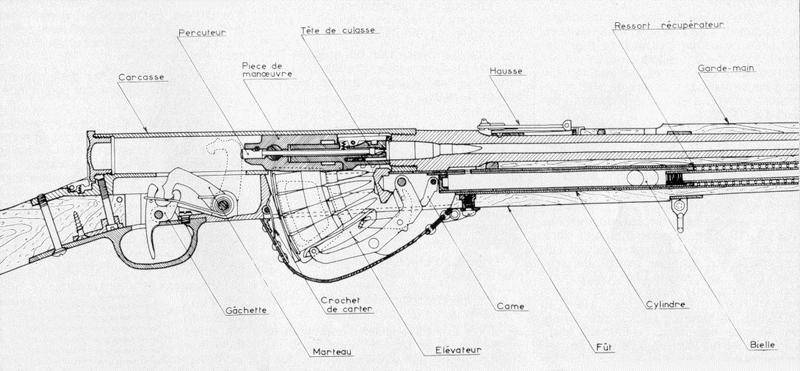
The scheme of the internal structure of the weapon. Figure Armesfrancaises.free.fr
At the time of the shot, the powder gases from the barrel bore entered the gas chamber, where they interacted with the piston and forced it to move backward, compressing the return spring. At the same time, the side thrust of the gas engine pushed the bolt handle back. When this happened, the interaction of the shutter with the slots of the frame, forcing it to rotate and unlock the barrel. During the movement of the released gate back, extraction and release of the sleeve occurred. Also at this moment, the back of the shutter pressed back and down the trigger, bringing it to the clutch with the trigger.
After maximum compression, the gas piston return spring should have returned all parts to their original position. She worked on the piston, which with the help of thrust pulled the bolt forward. USM remained in the cocked position, and the bolt group picked up the upper cartridge from the store and sent it to the chamber. In the forward position, the bolt rotated, locking the barrel. After that, the rifle was ready for a new shot.
The development of the Fusil Automatique Modèle 1917 rifle began in the spring of 1916, however, it was possible to complete the necessary work and prepare the mass production only by April of 1917. The first serial self-loading rifles of the new type left the assembly line and went into the army until the end of the spring 1917 of the year. Production of such weapons continued until September 1918. In about a year and a half, the French industry launched more than 85,3 thousand rifles designed by Ribeirol, Sutter and Schoes. The vast majority of manufactured rifles before the end of the First World War managed to transfer to the troops.
The use of weapons by the troops showed both advantages and disadvantages of the original design. The possibility of making several shots in a row without manual reloading was a great advantage over the various rifles that were in service with all the participants of the First World War. In addition, the used cartridge provided the required firepower, and also allowed to simplify the supply of ammunition units. It should be recalled that one of the main claims to the Meunier A6 self-loading rifle concerned the use of the 7x57 mm cartridge, which seriously hampered logistics and supply.
However, it was not without problems. The gas automatics were not perfect, because of which there could be delays in the shooting. There were also problems with the original design store. The need to open the cover for the installation of the clip led to the risk of contamination of the weapon, including the loss of efficiency. The relative complexity of the ammunition supply system also did not increase the reliability of the store. The existing shortcomings did not make the operation of the RSC M1917 rifles impossible, but they seriously hampered it.
Having received a list of claims of the military, the design team engaged in updating and improving the rifle. The result of this work was the appearance of the Fusil Automatique Modèle 1918 / RSC M1918 rifle. To avoid contamination of the weapon, the design of the receiver, which received an additional cover, was changed. In addition, the power supply system has undergone significant changes. It was rebuilt to use more comfortable clips for five rounds borrowed from Bertier carbine arr. 1916. A slide delay also appeared, which allowed to reduce the time for reloading the weapon after the ammunition was used up. The RSC M1918 rifle also differed from the base model in lower weight: it was able to bring it to the 4,8 kg.
On the basis of an improved rifle, a carbine was created that was distinguished by its smaller size. From the point of view of automation design, it was a copy of the Fusil Automatique Modèle 1918, however, it had a length of 1,1 m with an 580-mm barrel and weighed less than 4,5 kg. The carbine had a high degree of unification with the base rifle and, in fact, differed from it only by a shorter barrel, a gas engine and a forearm.
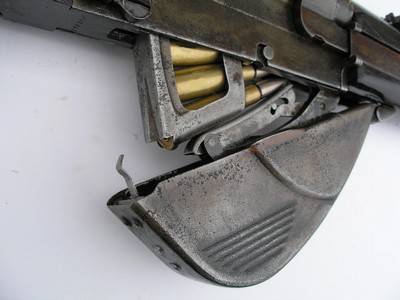
Store with the lid open, inside the holder with cartridges. Photo Forgottenweapons.com
Self-loading rifle and carbine mod. 1918 r. Entered the series by the end of autumn. Since November, over the next few months, the industry managed to release only 4 thousand upgraded rifles and a number of carbines. In view of the end of the First World War, the further production of new small arms was considered inexpedient. Defense orders were drastically reduced or completely canceled. For this reason, the production of the Fusil Automatique Modèle 1918 rifles was discontinued. In total, from the spring of 1917 to the beginning of 19, the French army received a little more than 90 thousand weapons of three versions.
Ribeirol-Sutter-Shosh rifles managed to take part in the First World War, but the comparative small production volumes did not allow for a great influence on the course of the battles. Upgraded rifles RSC M1918 did not have time to get to the front. However, in the future they managed to become a weapon of the warring army.
The first conflict in which all versions of the Fusil Automatique Modèle 1917 rifle were used was the Spanish-French-Moroccan War (Reef War) 1921-26. In 1925, France entered the war with the Republic of Rifa, sending thousands of soldiers to 125. The French contingent had various weapons, including rifles and RSC M1917 / 1918 carbines. Within a few months, Spain and France, by joint efforts, broke down the resistance of the enemy and won. At the end of May 1926, the Reef War ended.
According to various sources, in 1926, the decision was also made to remove Fusil Automatique Modèle 1917 rifles from service because of moral and physical obsolescence. Available rifles in stock were sent to warehouses and were no longer considered as weapons of the regular army. However, rifles were considered acceptable weapons for the reserve. In connection with the deterioration of the political situation in Europe, in 1935, the remake of the remaining rifles on the updated project began. Vent holes were closed and gas engine units were removed, after which the rifle should be used as a simple shop with manual reloading.
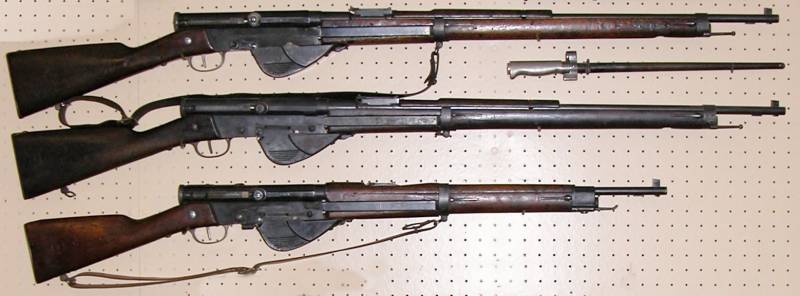
Weapons of the Fusil Automatique Modèle 1917 family (from top to bottom): M1917, M1918, carbine mod. 1918 Photo by Forgottenweapons.com
A number of rifles that have been reworked and have lost the ability to automatically reload, in 1940, became a trophy of Nazi Germany. Rifles suitable for use received a new designation of Selbstlade-Gewehr 310 (f) and were limitedly used by Volkssturm units. Due to their complete obsolescence, as well as due to alterations that did not improve their performance, such rifles could no longer be considered modern weapons capable of increasing the effectiveness of the combat work of the troops.
After World War II, the vast majority of the remaining RSC M1917 / 1918 rifles were written off and sent for recycling. Several samples of rifles and carbines have survived to our time, and are now exhibits of museums and private collections in several countries.
The Fusil Automatique Modèle 1917 semi-automatic rifle was developed after the outbreak of the First World War and was the answer to the existing challenges. With limited resources, the project authors managed to solve a number of critical tasks and bring a new weapon to mass production. However, this happened only in the 1917 year, which is why it was not possible to equip the army with the required number of weapons. As a result, the new rifles gained some acceptance, although they could not compete with existing weapons. After the end of the war, the RSC M1917 could find use in new conflicts, but the further development of self-loading systems made these rifles unnecessary.
On the materials of the sites:
http://world.guns.ru/
http://historicalfirearms.info/
http://forgottenweapons.com/
http://militaryfactory.com/
http://armes-ufa.com/
http://armesfrancaises.free.fr/


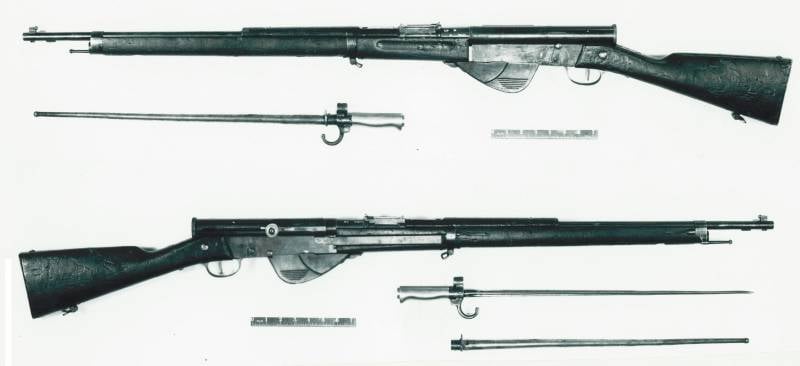

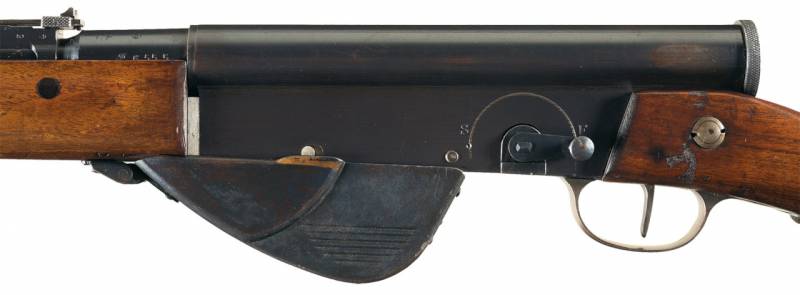
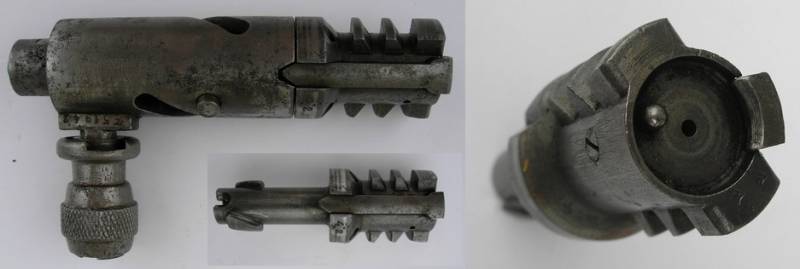
Information